ALLIGATOR
BEHAVIOR page 4b: FEEDING page 2 page 1 3 4 5 6 7 8 9 10 11
This
page was born 07/05/2008. Rickubis designed it. (such as
it
is.) Last update: 07/14/2015
Images
and contents on this page copyright ©2001-2015
Richard M. Dashnau
Most
people have seen programs on television showing crocodiles
attacking large
animals like deer and cattle. While this is amazing, and
sometimes horrifying,
those
creatures are not alligators. The function of a
crocodile's teeth is somewhat different than an alligator's.
Alligators favor prey
items that will fit inside their head. That is,
if they can swallow it
whole, then they will normally attack it. While I've heard
witnesses tell
of alligators taking deer in the park, the prey was very small
fawns. Alligators
have also been seen with large nutria. But, most of the time,
they will
eat things like small fish, frogs, and crayfish. Snakes and
turtles are
also pursued, with alligators
seeming to be especially well-adapted for
eating turtles. A recent study done in Texas examined the
stomach contents
of about 50 alligators (which were unharmed).
Research showed that only
one of these alligators had eaten a bird (which couldn't be
identified,
it might have already been carrion when taken), and the rest
had
stomach
full of small fish and shellfish. I've seen 11-foot
alligators going
after prey that was no larger than their largest teeth (very
small frogs
and fish).
January
18, 2004Okay,
so we got a little cool weather today. No big deal. Not when
compared
to the below-zero (F!) temperatures that have been reported in the
Northeast
US this
week! So, the temperature stayed under 45 degrees, or at least
it felt that way at Brazos Bend State Park. We'd gotten about 3
inches
of rain recently, so water was high, and it was
flowing nicely over the
spillway between Pilant Lake and Pilant Slough. If the weather had
been
a bit warmer (perhaps mid-sixties with lots of sun), alligators
would have
been there,
looking for fish being swept through the spillway. The alligators
didn't show, but quite a few of our wading birds did.
Visitor attendance
at the park was slow, and it was a pleasure to
be outside at the silent
park watching the wading birds fishing (a lot of them seemed to be
eating
crawfish).
A little
later, I had returned to the bridge from the direction of the
Observation
Tower. At the tower end, I noticed a large alligator in the
water
(the entire head was over 12 inches long).
All that showed was the top
of its head, and its nostrils (DON'T LIKE COLD, below). I shouted
to some
visitors who'd just passed if they had seen the alligator. A few
minutes
later, this
alligator raised its snout about and inch out of the water,
and made one snort. Then it submerged its head as shown, and a few
bubbles
came from its mouth. I was about 8 feet away.
As I looked at this alligator
through my binoculars (close-focus binoculars are very useful),
I
noticed something odd (see SOMETHING WRONG, below). For one
thing,
its eye seems
to be damaged (see BAD EYE, below). I moved a little
closer, and tried to get a look from the side (see SIDE OF HEAD).
To me,
it looks like a twig of some kind is broken off
behind the eye, and about
one-half inch in from the crease at the back of the eye (see
THORN?, below,
near the center of the picture). I couldn't see any better than
this, so
I can't tell
what this is, or how this could have happened. The alligator's
eye is definitely bad, though. The alligator never showed any more
of itself
while I was watching, and it finally slowly (very
slowly) sank under the
water.
This
was one of only two alligators I saw today. The other one was that
female
whom I've seen every weekend since Dec. 28, on the East side of
Elm
Lake.
Only her head was visible, near where I think she has a den. The
yearling
alligators were not visible.
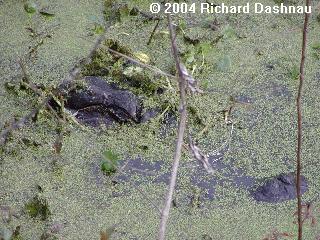 -
-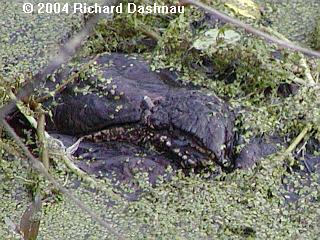 -
-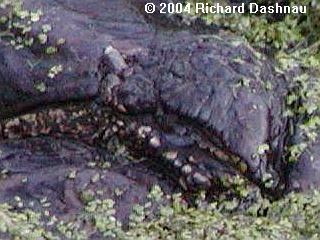
I
DON'T
LIKE COLD!
SOMETHING
WRONG
BAD
EYE
-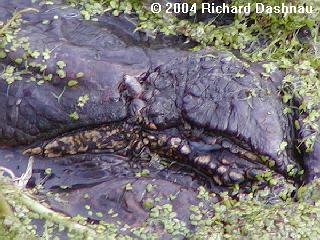 -
-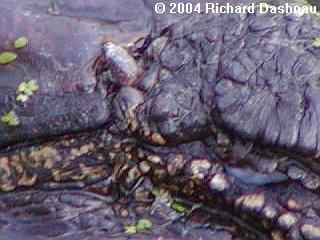
SIDE
OF
HEAD
THORN?
January
25, 2004
Finally, at the Spillway Bridge, I could see the three alligators.
They
were on one side of the bridge, about 12 feet away. On the other
side of
the bridge, though, there
was another alligator directly below! Unfortunately,
this one is in pretty bad shape, and is probably the one that's
been reported
around that area since last summer. I'm certain that this
is the same alligator
I saw last week. This time, the entire body is visible, and
he's
really emaciated (see SICK 'GATOR, below). The backbone is
actually protruding,
and the flesh
behind the head and around the front leg joints is sunken
(see, DORSAL DETAIL, below). I looked closer at the head, and saw
that
the same eye damage I'd noticed last week was
visible, but the other eye
is also gone. Close inspection through binoculars showed the left
socket
to be filled with sunken, milky tissue (see SHRUNKEN HEAD, below).
So,
sadly, this
alligator is totally blind.
--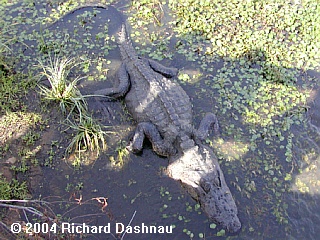 ----
----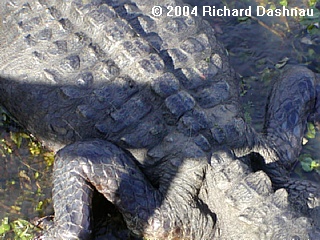 ---
---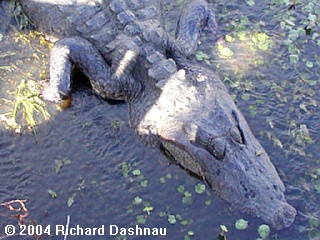 --
--
SICK
'GATOR
DORSAL
DETAIL
SHRUNKEN
HEAD
It's
hard to say how this happened. I can't see any other scar tissue,
so I
don't think another alligator did this, although it's
possible. I'd
hate to think that he was purposely maimed by one
of the park visitors.
In any case, it's sad to see this large (at least 10 foot long)
specimen
in such a state. Although he's evidently blind, he can still hunt,
after
a fashion. For one thing, his
senses of hearing and smell still work. He
can also use the Integumentary Sense Organs on his jaws (see Alligators
page 4 FEEDING )
to find food. He can also eat any carrion he can
find. He almost certainly
will never again eat enough to maintain a decent body mass, and
will probably
eventually starve to death. The park staff usually lets nature
take its
course with the
animals in the park. The point is to allow the animals
to be wild. As with certain other examples of the wheel of life, I
don't
have to like this, but there it is.
February
15, 2004Today's
weather was bright, and cold (mid 30's to mid 40's). I didn't see
much
when I was on the trails before lunchtime, but I heard, later in
the afternoon,
about two
interesting items. The first was a large alligator with a nutria
in its mouth on the island in Elm Lake across from the area
between piers
2 and 3. I heard about this around 4 o'clock PM,
but went out to
see anyway. And, it was there, although difficult to see. I got a
few pictures,
but at that distance, and through brush, they didn't come out
well. (see
HAIRY MOUTHFUL,
below, and be sure to click on the image)
---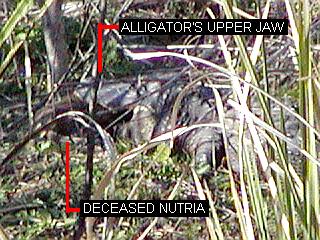 ------------------------------
------------------------------
HAIRY MOUTHFUL
Still,
it is a noteworthy event, since I heard (I'll have to see if I can
find
this in some literature somewhere) that alligators can't digest
prey if
their internal temperature drops below 70 degrees
fahrenheit. Since we've
had low temperatures (40 degrees +\- 5 degrees) for the last week
or so,
it stands to reason that the alligators are all below this
temperature.
If at all possible the
park naturalists will see if the alligator actually
eats the nutria, or leaves it. While I watched for about 15
minutes, the
alligator didn't move at all, but just laid there with the mass of
the
nutria
in its jaws. Mark, the volunteer who told me about this, said he'd
first seen it at about 12:00 today, near the time I was in the VC
giving
my alligator program. So, the alligator had been in
this situation for
at least 4 hours by the time I saw it.
After
looking at the alligator with its nutria, I went and looked for
the log,
which turned out to be less than 5 minutes' walk from one of our
parking
areas.
November
28, 2004Today
was certainly a NON-typical day at Brazos Bend State park. The
Brazos River,
and Big Creek-which meet at the Southeast end of the park-were
both swollen
with rainwater, and were much higher than usual. The Brazos River
had breached
its banks, and Big Creek was backflowing into the park via Pilant
Slough,
although it had already breached
its banks in some areas. I was on the
trails in the morning, and it was a beautiful day.
--------------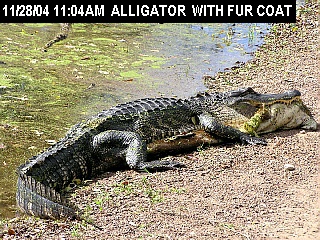
 -
-
ALLIGATOR
WITH SKIN
WITH SKIN CLOSER
However,
the water slowly crept into the park. Here are some pictures I took
as
I walked the park, and also did a short riding patrol with Chuck and
Sharon.
I had scheduled two interpretive
programs, or else I would have stayed
out on the trails longer. The picture above shows an alligator that
had
come up onto the 40-Acre Lake trail (which hadn't flooded...yet)
with a
deerskin
in its jaws (I said the alligator had a fur coat. I didn't say
it was wearingit.)
The
skin had probably gotten washed into the water by the flooding,
where
the alligator had found it. The alligator
moved back into the water and
slowly swam off when I got closer.
UPDATE 12/04/2004:
Chuck
Duplant and Sharon Hanzik had dropped me off at the VC/NC so I
could do
my programs. While I was inside doing my programs, we had another
alligator
eating turtle incident by Elm
Lake. Chuck was there with his camera,
though, and got some pictures, which he was kind enough to share
with me.
He's also given me permission to post them here. Mark Garbutt was
also
there, and he described what happened. They were near one of the
Elm Lake
benches (one that I'd cleared the rice in front of) and were
watching a
small alligator in Elm Lake, when one of the
visitors exclamed something
like "Holy Cow, look at that!" and a large alligator
(about 9 ft.?)
came from Pilant Lake, got up on the trail in front of everyone
and-in
about 45 minutes-crushed and
swallowed a good-sized pond turtle.
Below are images I made from a series of 4 that Chuck Duplant
emailed us.
Thanks Chuck, for letting me use them here! One of these
days, I'll
get to
witness an event like this. I have another incident of this type
(photos and videos taken by John Bradford) shown on my webpages here.
I have read that part of the reason that alligators have
evolved their
tremendous jaw muscles and heavy, strong skulls is to take
advantage of
this
food source. That is; large, slow-moving turtles. This
may
make some sense, since alligators
haven't also evolved the meshed-tooth
arrangement that the crocodiles have for efficiently tearing large
carcasses
apart. Also note that the entire turtle is swallowed. I
mean that
the shell
fragments are not spat out, or picked through.
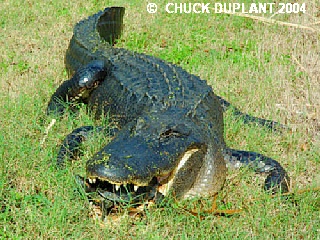 -
-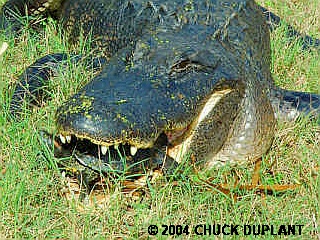 -
-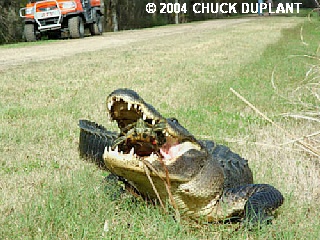 -
-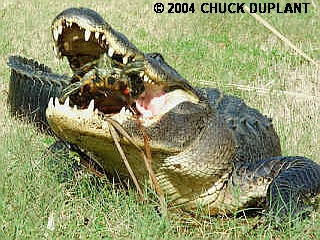 -
-
UP ON THE
BANK
ON
THE BANK--
CLOSER
HARD TO SWALLOW
HARD TO
SWALLOW--
CLOSER
----------------------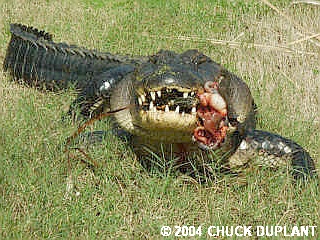 ----------
----------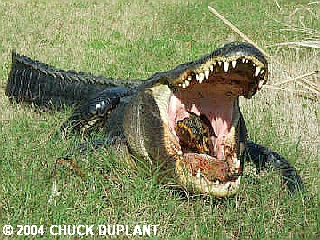 -
-
FINALLY
THE
SHELL IS
BREACHED
EVERYTHING
IS SWALLOWED AND DIGESTED
And,
this page shows alligators at the park,
on land, near various landmarks at the park.
Go back to my main alligator
page, Alligators
Go
back to my home page, Welcome
to rickubis.com
Go
to the main
alligator page
 -
- -
-













